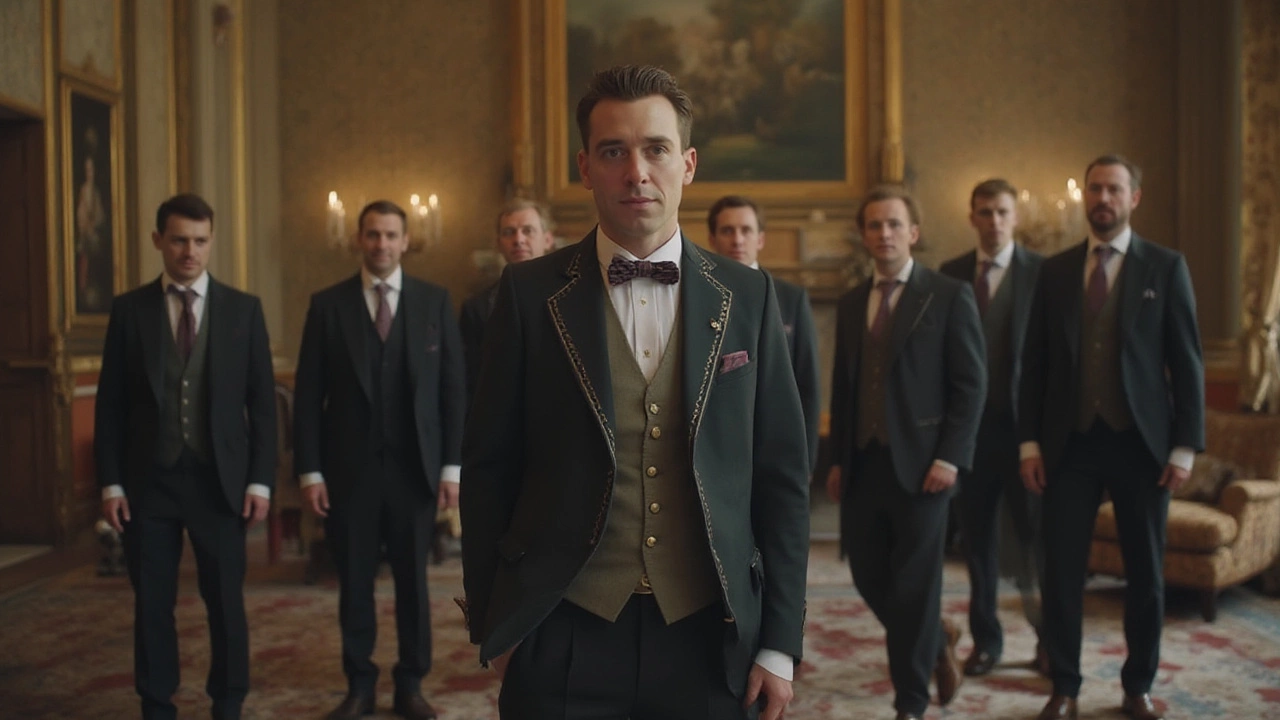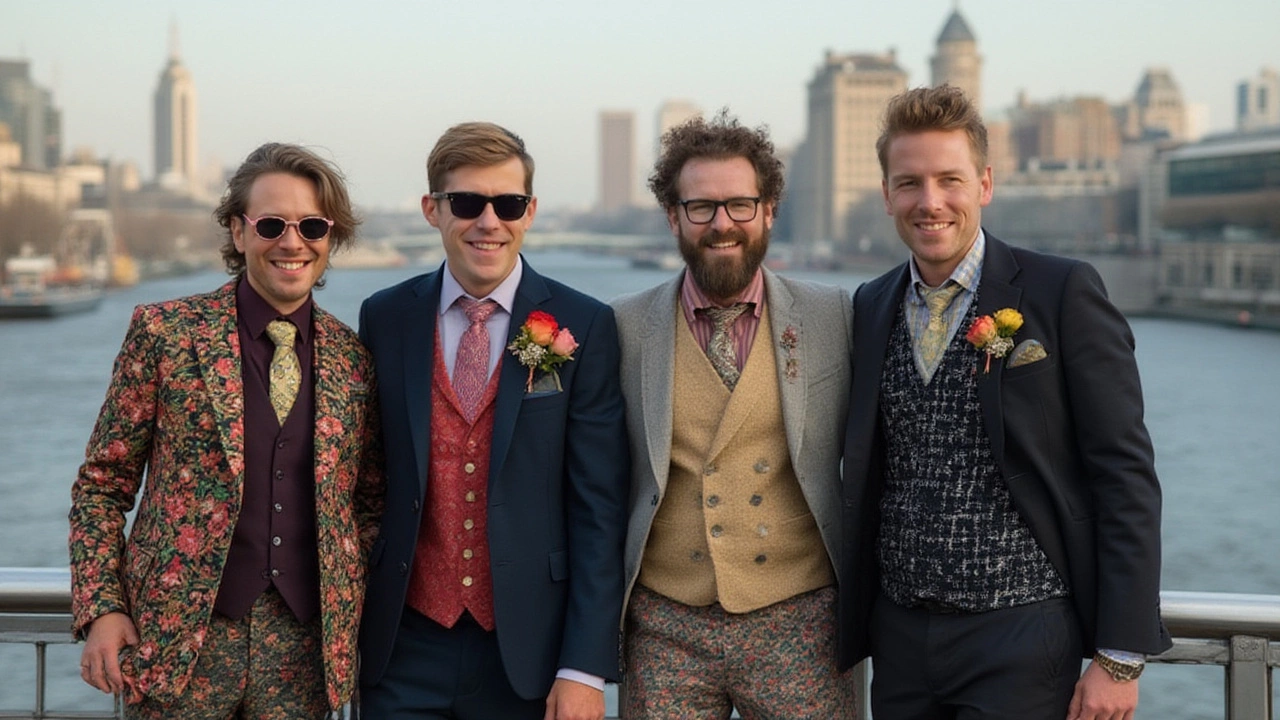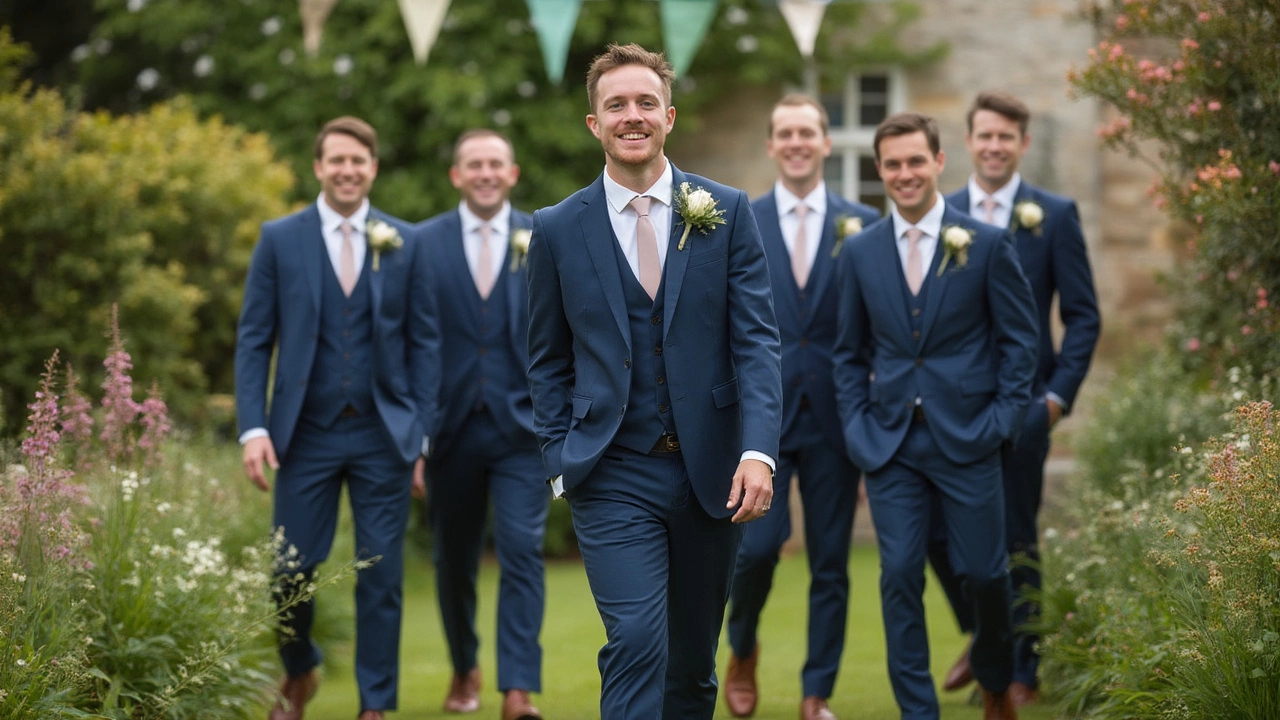What’s the worst groom suit disaster you’ve seen? I once watched a best friend panic when his groomsmen all showed up in wildly different shades of blue. We teased him about being caught in a group of Smurfs. But after the laughter, someone asked: does the groom’s suit really have to match the groomsmen? Or is it more about personality and style? Let’s rip apart the old rules about matching suits, and see what actually matters if you want a wedding party that looks sharp, feels good, and turns heads for the right reasons.
Tradition Meets Reality: Where Did the Matching Rule Come From?
Think back to the weddings your parents (or maybe even your grandparents) attended. Matching groomsmen and groom suits were standard because, well, uniformity felt reassuring. It gave instant cohesion to wedding photos. Maybe it was simpler back then when men wore tuxedos and called it a day. But even as far back as the 1800s, Victorians loved strict dress codes at formal occasions. Grooms wore something extra, like a flower boutonniere or a silk cravat, as their distinguishing mark. Fast forward to the mid-20th century, and matching rentals became mainstream. The ‘penguin-suit’ era of black tuxedos and pastel-accented bow ties defined whole decades of photos.
Here’s an interesting nugget: New Zealand’s own vintage wedding snapshots from the 60s and 70s are full of matching brown suits (yep, brown!). It was less about fashion and more about group identity. In Māori weddings, matching attire was sometimes linked to whānau (family) pride. You can see how these old customs shaped the expectation that the groom shouldn’t stand apart.
But is there a written rule anywhere? Turns out, etiquette books suggest the groom might want to wear something different, but most just say, "coordinate for group harmony." Not exactly a hard-and-fast law. In fact, according to a survey by The Knot in 2023, nearly 53% of grooms wore something only "loosely matching" to their groomsmen. While old habits linger in tradition, today’s reality is way more forgiving—and interesting if you ask me.
The Pros and Cons of Perfectly Matching Suits
So what are the actual benefits of going matchy-matchy? Let’s get real: a line-up of friends in identical navy suits and classic brown shoes looks amazing on camera. It makes colour palettes, flowers, and backdrops just pop. For couples after a timeless vibe, a perfectly matched group fits the fairytale vision—a strong, united squad supporting the groom.
There’s also the psychological aspect. When everyone matches, there’s less guesswork. Groomsmen aren’t nervously texting the night before asking, "Wait—navy or midnight blue?" Boutiques and rental shops leap at this concept because it guarantees more sales or rentals of one chosen outfit, simplifying the shopping chaos. There’s an undeniable magic in stepping into a room and seeing your best mates looking effortlessly coordinated. For some grooms, especially in big weddings or with friends flying in from multiple cities, keeping things simple can be a sweet kind of stress relief.
But there’s a flip side. Sometimes an army of look-alike suits feels, dare I say it, bland. Nobody wants bridesmaids and groomsmen blurring together in a sea of sameness—especially in 2025, when weddings are about expressing individuality as much as celebrating togetherness. Then there’s body type. One suit does not fit or flatter all. Some mates love modern slim-fit; others feel like they’re in sausage casings. For self-funded parties, matching suits can be a money pit with little re-wear value—never mind the headache of tailoring. I’ve heard many kiwi couples say, "Our crew is a wild bunch—coordination, not carbon copies, works for us."
| Matching Style | Photo Appeal | Ease of Planning | Self-Expression | Budget Friendliness |
|---|---|---|---|---|
| Exact Match | High | Simple | Low | Varies |
| Coordinated (Similar hues, styles) | Great | Moderate | Moderate | Often better |
| Mix & Match | Distinctive | Complex | High | Flexible |

Creative Ways to Mix It Up: Standout Groom, Unified Groomsmen
If you want your own suit to pop without leaving your mates in the dust, the options are endless. Ever seen a groom in a bold emerald velvet jacket, with his guys wearing classic black or charcoal? It’s a look that feels intentional, not attention-seeking. Or, flip it: let the groomsmen wear lighter-coloured suits, and choose a rich, darker tone for the groom. It works—especially at venues that play with nature, like a beach or vineyard here in Auckland.
Some wedding parties skip matching jackets altogether, especially for summer weddings. Maybe just vests, suspenders, and coordinating trousers—in New Zealand, where outdoor weddings are a thing nearly year-round, this is gaining steam. Another riff: all the men wear the same base (say, classic navy), but the groom differentiates with a patterned tie, a unique waistcoat, or a subtle but striking boutonnière. Even little details like unique cufflinks or shoes can give that one-off effect.
One groom I know was a huge rugby fan, so he and his best man wore socks in their team’s colours, and the rest of the party did the same. It gave a private nod to their friendship and looked awesome in photos. I’ve also seen Maori and Pasifika couples blend modern suits with traditional taonga or woven sashes for the groom, with the group embracing matching shirts or subtle lapel pins.
- Pick one differentiating detail: waistcoat, tie, or jacket shade
- Coordinate, don’t clone: same colour family, not identical fonts
- Accessories matter: pocket squares, socks, and boutonnières
- Comfort is king: skip jackets for a relaxed vibe
- Local culture: fuse personal heritage with western attire
These small but powerful choices keep your style personal, but the groom suit match is still visible in the group dynamic—the perfect blend of standout and unity.
Colour, Fit, and Fabric: What Matters Most
Maybe you’ve found “the” suit—a perfect fit that makes you stand a little taller—but now you’re stressing about how closely everyone else needs to match. Breathe. Colour is your best friend when it comes to setting the tone. According to stats from New Zealand formalwear boutiques, navy is hands-down the most popular, with 38% of grooms in 2024 choosing some shade of blue, closely followed by grey and charcoal.
Fabric plays a huge role in New Zealand, especially with our unpredictable weather. Lightweight linen blends rule in summer; heavier wools in the colder months. No groomsman wants to sweat bullets in a three-piece suit on Waiheke Island in January. Matching texture actually creates a more unified look than exact colours—so if one mate packs a suit from home that’s a slightly different blue but the same weave, it still looks cohesive in photos.
Here’s a tip from some of Auckland’s top tailors: Fit matters more than matching. Groomsmen in well-fitted, comfortable suits always look more confident—regardless of shade or accessory. If you’re blending rented and personal suits, take time for a quick tailoring session. It doesn’t cost much, but it pays off on the day (and in every photo). There’s nothing worse than someone yanking at their cuffs because the jacket sleeves are too long.
If you want to get creative, try these combos:
- Groom in dark navy, groomsmen in medium blue
- Groom in patterned (like plaid), mates in solid colours
- Groom in a tux, groomsmen in classic suits
- Groom and best man one colour, other groomsmen another
Make your “rules” together as a couple—there’s no law that says everyone has to match to a T. If you’re bold enough to break with tradition, do it with intention, not just at random. That’s the difference between looking unique and looking like you forgot to coordinate.

New Zealand Trends and Inspo: Real Couples, Real Choices
Today’s Auckland weddings are a blend of city style and backyard casual—often with at least one muddy farm dog trying to sneak into group photos. Local couples are big on sustainability—so there’s a trend toward choosing suits that can be worn to work or special occasions later. It’s not uncommon to see the groom in a stand-out colour, with his party in different, slightly more versatile shades.
Props to Kiwi couples who swap jackets for open collars, or play with unique accessories like pounamu necklaces and woven flax pins. That personal touch becomes the memory. One couple from my neighbourhood had the groom in a white dinner jacket, and the guys in black shirts and trousers—with the bride in bamboo silk and barefoot. It was stylish, fun, and nobody looked out of place.
If you want a pure city feel, hired tuxedos and patent shoes are still in, especially for black-tie celebrations in downtown Auckland. But for garden and vineyard weddings, mixes of blues, greys, or even deep forest greens reign. A fun Kiwi fact: New Zealand designers like Working Style and Barkers now offer “Groom’s Club” packages, letting the groom pick something unique while his party mixes and matches within a theme. It reduces waste, gives everyone more input, and keeps the energy relaxed.
| Popular Groom Attire (NZ, 2024-2025) | Percentage Chosen |
|---|---|
| Navy Suit/Tux | 38% |
| Grey/Charcoal Suit | 26% |
| Mix-and-Match Suits | 19% |
| Coloured/Patterned Suit | 8% |
| Traditional Tuxedo | 6% |
| Other (linen, casual, cultural) | 3% |
Lately, I’ve seen grooms do quick “wardrobe reveals”—switching up jackets or accessories before the reception for a new mood. It keeps things fresh. Ask your photographer for input—NZ pros are great at coaxing the best looks from sometimes chaotic combos. Worst-case scenario? If your style flops, at least you’ll have a good story for the wedding video.

